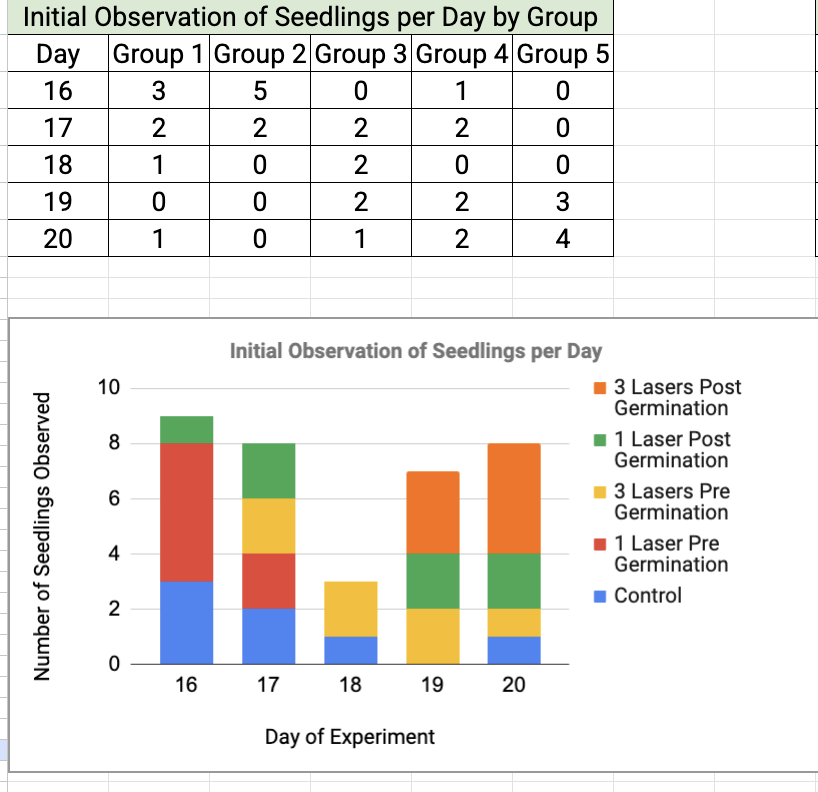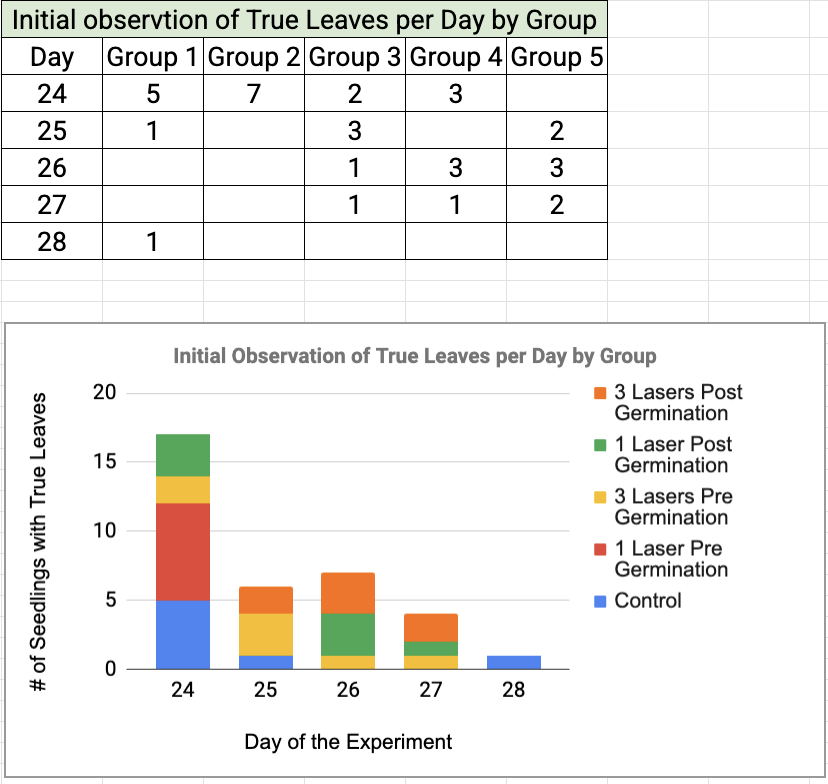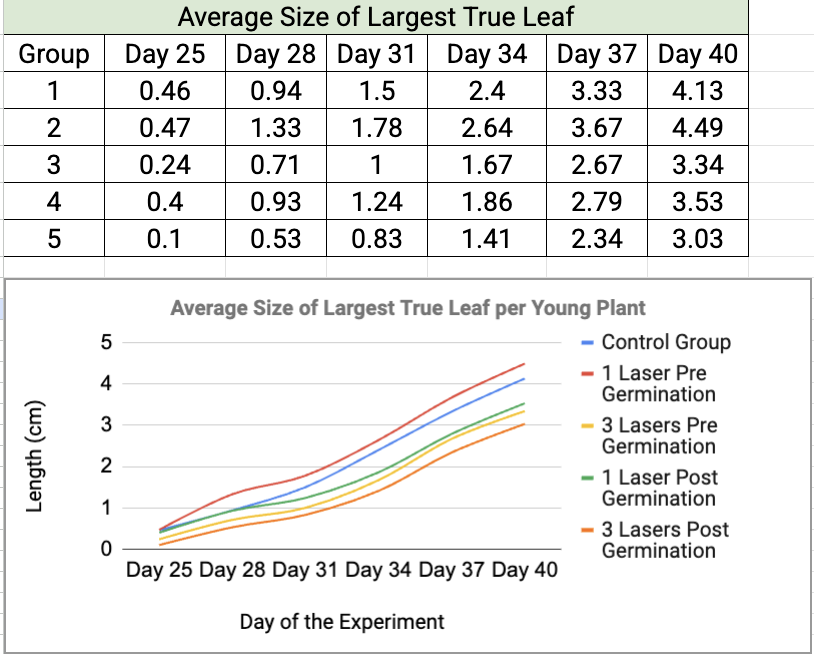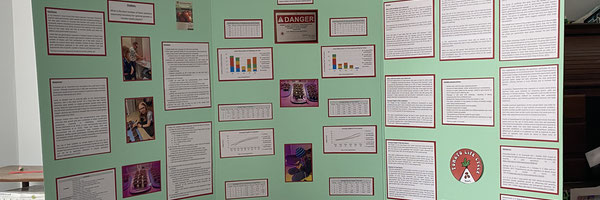Radiating Growth: The Influence of Laser Light on Tomato Plants
Grade 6
Presentation
No video provided
Hypothesis
In my research I have found that laser exposure has been shown to improve seed germination, plant growth and rate of photosynthesis. It has also been shown to increase the number and quality of fruits produced, improve resistance to disease and environmental stressors (Rivera-Talamantes et al, 2023). However, the majority of the research done on this topic does not look at tomato seeds and does not address post germination exposure.
I think that pre-germination exposure of tomato seeds to Class 4 low level laser radiation will quicken germination, improve rate of growth, number of leaves, and fruit production, as it has been shown in studies on various other plant varieties. Further to this, I think that post germination exposure to the same laser radiation will also improve the rate of growth, number of leaves, and fruit production.
This has not been extensively studied in tomato plants, yet.
Research
Tomatoes are an important food throughout the world and in many cultures. Although tomatoes have a high yield percentage, increased production would result in more money or economic value and more food (Rivera-Talamantes et al, 2022).
Laser is situated next to infra-red light on the electromagnetic spectrum, and it has been known for a long time that warmth stimulates plant growth, i.e. seeds germinate quicker when spring arrives. When the Laser enters the seed cell it stimulates structures in the cell which transforms the light energy into chemical energy which triggers physical and chemical changes that enhance seed growth (Mohammadi et al, 2023).
Previous studies have shown that pre-germination laser radiation promotes early growth and also contributes to better overall plant productivity especially in challenging environments (Rivera-Talamantes et al, 2023), or from sub-optimally seed stores (Rivera-Talamantes et al, 2022). Yahya and Sultan, 2022 also demonstrated that pre germination laser irradiation positively influences various growth parameters, including seed germination and lycopene content, which is a potent antioxidant and contributes to the nutritional value and health benefits of tomatoes.
The use of laser radiation on tomato plants is low cost, low in chemicals and is considered environmentally friendly (Qi et al, 2000). Studies have shown that this results in more food, better quality food and can be an applicable treatment to organic agriculture (Rivera-Talamantes et al 2023).
Variables

Procedure
- Divide seeds into 5 groups of 8 (40 total) and label
- Plan laser exposure dates for pre germination laser exposures - every 3 days until 3 laser exposures are completed
- Ensure group 2’s single exposure aligns with group 3’s 3rd exposure so planting occurs on the same day
- Perform pre germination laser exposures at LEP under the operation of RC, ensuring all safety measures are implemented
- 1 hour prior to laser exposure apply 5ml of water to seeds to ensure they do not dry out during laser exposure
- Dry seeds
- Apply the laser
- Repeat procedure on all 3 laser days; on the third day 2 groups will receive laser exposure
- Planting for all 5 Groups:
- Label the pots with the corresponding group number (1,2,3,4,5) and a seed number (a,b,c,d,e,f,g,h)
- Weigh out 65g of soil and add it to each pot (40 in total)
- Add 60 ml of water to each pot via syringe to moisten the soil
- Plant tomato seeds in each pot to a depth of 6mm, then cover the seed
- NOTE: any seeds that have not sprouted by measuring time (8pm) on day 22 of the experiment will be considered “non sprouting” and be excluded from the results
- Arrange the pots on trays and cover the pots with plastic lids to ensure the soil does not dry out
- Monitor the pots daily at 8pm to see if the seeds have germinated; recover with plastic lids
- When the seedling is first observed, record the date of “sprout” and also the initial height of the seedling
- Collect and record measurements every 3 days (from the day of first overall seedling was observed)
- H = Height of Cotyledon
- #L = # of True Leaves
- SL = Size of Largest True Leaf
- HL = Height of True Leaves
- F = Fruit
- Collect and record measurements every 3 days (from the day of first overall seedling was observed)
- On the date where the first seedling is noted, remove the plastic lids from the pots and turn on the grow lights
- Turn grow light on for 12 hours a day; from 8am - 8pm
- Plant trays are rotated every 3 days under the grow lights
- Monitor the moisture of the soil daily to prevent drying out
- Water each pot every other day or when soil is drying out
- Add 20 ml via syringe to each pot
- Be sure to keep watering consistent across all groups
- Continue to check on the pots daily at 8pm and record any new seedlings
- Record the date and height of the initial sprout
- Perform the post germination laser exposure when all group 4 and 5 seeds have sprouted or 15 days after they were planted
- Group 4 (1 post germination laser exposure) and Group 5 (3 post germination laser exposures) will receive their first laser exposure on the same day
- Laser exposures will be performed at LEP under the operation of RC, ensuring all safety measures are implemented
- Group 5 will receive 2 additional laser exposures 3 days apart
- Group 4 (1 post germination laser exposure) and Group 5 (3 post germination laser exposures) will receive their first laser exposure on the same day
- Continue to collect and record measurements every 3 days up until day 40 of the experiment
Observations
Days until seedlings were observed:
The tomato seeds were planted on day 7 of the experiment, and the first seedling was observed on day 16; with a total 9 seedlings observed on this day. Over the next four days, an additional 26 seedlings were observed giving a germination rate of 87.50 % by day 22. Any seeds that had not germinated by day 22 are considered outliers and excluded from the data.
One thing to note is that the final germination rate was 95.00% which is comparable to the germination rate outlined by West Coast Seeds (98.00%).
From the data it was clear that the seeds that received 1 laser exposure pre germination had the highest percent of seedlings (fastest rate of growth) on day 16, with 55.56%; the next closest group was the control with 33.33% . The group that received 1 laser exposure pre germination had a germination rate of 87.5% by day 17 and the remaining seed failed to germinate.
An interesting finding was that seedlings in the groups that were set to receive 1 and 3 post germination laser exposures should have had a growth rate similar to the control as at that time in the experiment as none of the three groups had been exposed to laser at this point.
Days until true leaves were observed:
The first observation of true leaves was seen on day 24, with a total of 17 seedlings showing true leaves. The group that received 1 laser exposure pre germination made up 41.18% of these. Interestingly all seedlings that germinated in the group that received 1 laser exposure pre germination showed true leaves on this day. Once again the next closest group was the control group coming in with 29.41%. The earlier observation of true leaves again shows that the group that received 1 laser exposure pre germination continued to grow at a faster rate when compared to the control group.
Average height of the cotyledon:
The height of the cotyledon (the embryonic leaves)(H) on each seedling/young plant were measured every three days and averaged across each experimental group. The average height of the cotyledon on the seedlings that received 1 laser exposure pre germination was 107.21% of the growth of the control group.
The other experimental groups all had a lower growth rate of the cotyledon when compared to the control group. The group that received 3 laser exposures pre germination grew 11.35% less than the control, whereas the 1 and 3 lasers post germination groups grew 7.34% and 7.88% less respectively.
Average height of the true leaves:
The height of the true leaves (HL) were measured every three days and averaged across each experimental group. The average height of the true leaves on the seedlings that received 1 laser exposure pre germination was 108.12% of the growth of the control group.
The other experimental groups all had a lower growth rate of the height of the true leaves when compared to the control group. The group that received 3 laser exposures pre germination grew 19.76% less than the control whereas the 1 and 3 lasers post germination groups grew 14.96% and 25.11% less respectively.
Number of true leaves:
The first observation of true leaves occurred on day 25. The number of true leaves (#L) on each seedling was noted from day 25 onwards in alignment with taking measurements every three days. The total number of true leaves observed was averaged across each experimental group. The group that received 1 laser exposure pre germination, had 20.35% more true leaves when compared to the control group; and the group that received 1 laser exposure post germination had 1.64% more true leaves.
The other two experimental groups both had a lower average number of true leaves when compared to the control group. The group that received 1 laser exposure pre germination had 7.77% less true leaves and the group that received 3 laser exposures post germination had 20.41% less true leaves.
Size of largest true leaf per plant per group:
The size of the largest true leaf (SL) on each seedling was measured and averaged across each experimental group. The group that received 1 laser exposure pre germination, had true leaves that were 108.72% larger than the control group.
Once again we saw that all other experimental groups had true leaves that were smaller than those in the control group, indicating a slower rate of growth. The next closest group to the control was the group that received 1 post germination laser exposure; with true leaves that were 14.53% less than the control.
The groups that received 3 laser exposures whether pre or post germination had true leaves that were 19.13% and 26.62% less than the size of the true leaves in the control group.
Unexpected/adverse effects:
On day 19 of the experiment, an unexpected observation was seen on seedling 3.f. When measurements were taken, it was observed that 3.f had two seedlings. I am unable to determine if it is a normal variance of the seed, the result of a normal mutation, or a direct result of the laser exposure.
From day 25 of the experiment it was seen that 3f had the lowest growth in all responding variables (H, HL, #L and SL) when compared to the other seedlings in the same group. This could be a result of the two seedlings receiving limited nutrients as it was fueling two separate seedlings.
When I look at the two groups that received pre germination laser exposures, the group that received 1 exposure had a higher rate of growth then the control group whereas the group that received 3 laser exposures had a growth rate lower than the control group. Although a step was taken to prevent the seeds from drying out, this shows that in this experimental environment there was no benefit to the additional laser exposures; and it was potentially too much that it hindered growth.
When we look at the groups that received one and three laser exposures post germination, it was seen that in this environment the post germination laser did not have a positive effect on the overall growth of the young plants
Analysis






Conclusion
The growth and development of the tomato plants is strongly influenced by the spectrum of the light in their environment (Li et al, 2021).
The group of seedlings that grew from the tomato seeds that received 1 laser exposure prior to germination showed superior growth and development compared to the control group. These plants germinated more quickly and demonstrated a higher growth rate as reflected in the size and number of both cotyledons and true leaves. This group of seedlings not only had more true leaves but also showed larger leaves, which suggest enhanced early stage development.
The limited time frame of this project means that all of the possible outcomes for the growth of the tomato plants may not be fully realized. It is hard to get a full idea of the effects of the responding variables. However, it is apparent that within this experimental design, the single pre germination laser group displays the best overall results.
Given these promising results it is likely that the laser exposure will continue to benefit the plants as they mature. The group that received the single laser exposure prior to germination is expected to produce more flowers and fruit than the control group. This increased flower and fruit production will likely translate into higher overall yields, potentially leading to more food being produced per plant, as is demonstrated in many of the previous articles (Rivera-Talamantes et al, 2022; Rivera-Talamantes et al, 2023; Yahya & Sultan, 2022).
The implications for farming are significant, particularly for those growing tomatoes on a commercial scale. The use of laser exposures could result in larger, more productive plants that require fewer seeds to produce the same amount of produce. This would not only optimize space usage but also accelerate the crop production process, offering farmers a more efficient way to increase their output.
In summary, implementing laser exposure on tomato seeds before planting holds great potential for improving growth, yield, and efficiency in tomato farming. This approach could provide farmers with a cost-effective method for boosting their productivity, enhancing revenue, and meeting growing food demands with fewer resources.
Application
Possible practical applications of this include better crop yields for smaller farmers and/or in less optimal environmental conditions. Another possible benefit would be to use in space travel as you could have less plants (take up less room), but plants that would grow at a faster rate, and produce more fruit in a shorter time frame.
Points of improvement for this type of study could include more data points such as the use of more plants, more time and potentially measuring fruit production. Another point of improvement could be to use tomato seeds that have been exposed to either space or space-like conditions i.e. weightlessness, temperature variations, differences in altitude or in pressure, as well as exposure to other types of radiation that would be found in these sorts of environments.
Sources Of Error
Possible Sources of Error:
- Human error with the laser exposure process
- Amount of water needed - either underwatering or overwatering
- Amount of water added by the syringe - ability to give exactly 20 ml of water on each watering day
- Changes in soil level with watering - resulting in taking measurements from a different level
- Reading the measurements off the micrometer or ruler
- The stem, cotyledon or true leaves not being completely straight when taking measurements
- Entering the data incorrectly onto the tables
- Random assignment of seeds
- Seeds came from the same batch but different packets due to the number of seeds per packet
- The positioning of the pots under the grow lights
- Not having enough grow lights to provide even distribution of light across all pots
- Planting depth of the seed
Citations
Dziwulska-Hunek, A., M. Szymanek and J. Stadnik. 2020. Impact of pre-sowing red light treatment of sweet corn seeds on the quality and quantity of yield. Agriculture. 10: 165. https://doi.org/10.3390/agriculturre10050165
Gavassi, M. A., C. C. Monteiro, M. L. Campos, H. C. Melo and R.F. Carvalho. 2017. Phytochromes are key regulators of abiotic stress responses in tomato. Sci. Hortic. 222: 126-135.https://doi.org/10.1016/j.scienta.2017.04.035
Li, Y., Z. Liu, Q. Shi, F. Yang and M. Wei. 2021. Mixed red and blue light promotes tomato seedlings growth by influencing leaf anatomy, photosynthesis, CO2 assimilation and endogenous hormones. Sci. Hortic. 290: 110500. https://doi.org/10.1016/j.scienta.2021.110500
Mohammadi, S., F. Shekari, R. Fotovat and A. Darudi. 2012. Effect of laser priming on canola yield and its components under salt stress. Int. Agrophysics. 26: 45-51.https://doi.org/10.2478/v10247-012-0007-9
Rivera-Talamantes, C. F. J. A., Michtchenko, A., González-López, G., Budagovsky, A. V., Correa-Coyac, D., Acosta, J. 2023. Influence of pre-sowing red laser irradiation of tomato seeds on the initial plant development, salinity stress tolerance, and harvest yield. Emirates Journal of Food and Agriculture 35(1): 40-47 https://doi.org/10.9755/ejfa.2023.v35.i1.2934
Rivera-Talamantes, C. F. J. A., Michtchenko, A. Budagovsky, G. González-López and E. Grosheva. 2022. Influence of red laser radiation on the vigour of tomato seeds affected by aging. Agrociencia. 56: 61-73. https://doi.org/10.47163/agrociencia.v56i1.2697
Qi, Z., M. Yue and X. L. Wang. 2000. Laser pretreatment protects cells of broad bean from UV-B radiation damage. J. Photochem. Photobiol. B. 33-37.
https://doi.org/10.1016/S1011-1344(00)00131-7
Yahya, R. T., & Sultan, S. J. (2022). Effect of exposing the seeds of tomato plant (Solanurlycopersicum L.) to diode laser rays on the germination, growth of hypocotyl stems callus of their seedlings and its content of lycopene. International Journal of Health Sciences, 6(1), 987-996. https://doi.org/10.53730/ihs.v6nS1.4844
Acknowledgement
My Dad (RC): for using his certification in class 4 lasers to provide the laser exposure on seeds and seedlings
My Parents: for providing me with all the supplies to carry out my experiment and supporting me throughout the experiment
Michelle L: for providing guidance on elements of a good experimental research project and ideas to consider for my topic
Helen M: for sharing her knowledge and experience of gardening, lending me her grow lights and small pots
Edward M: for sharing his knowledge of being a fruit and vegetable farmer in New Zealand
Jamie B: for crocheting five little tomatoes to add to my science fair display
Tomato Life Cycle Freebie - Wonder at the World: https://wonderattheworld.com/tomato-life-cycle/

